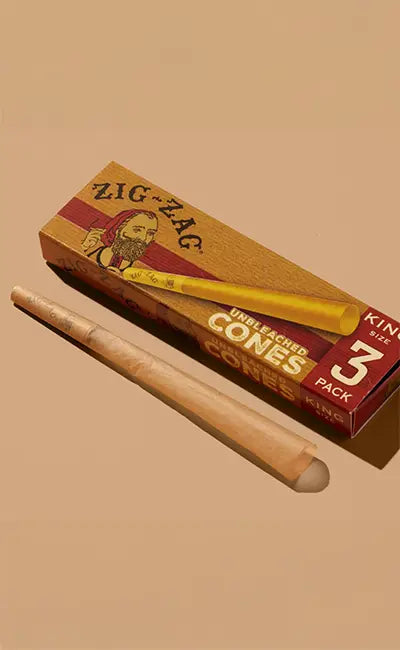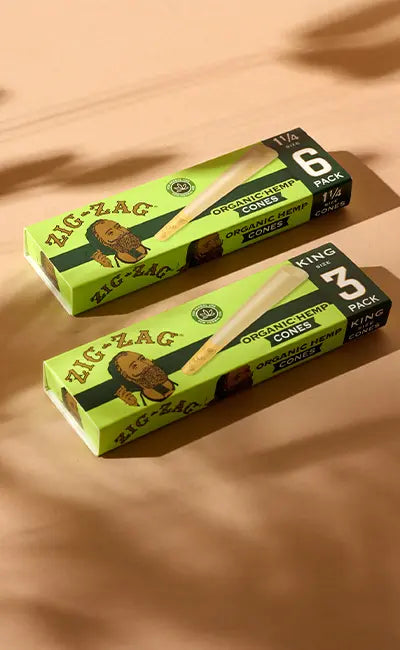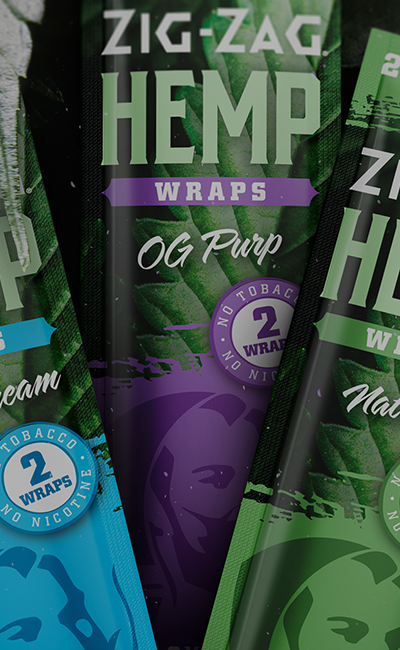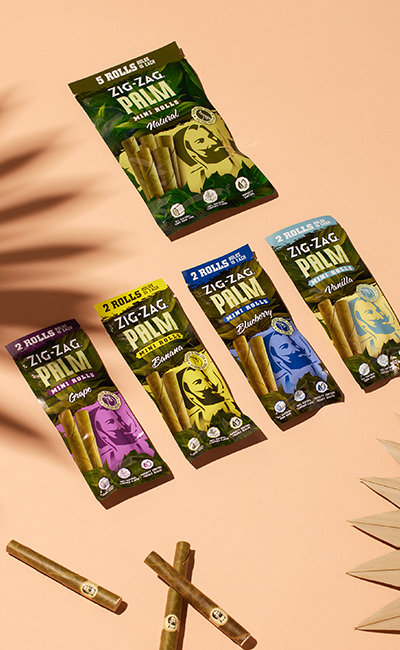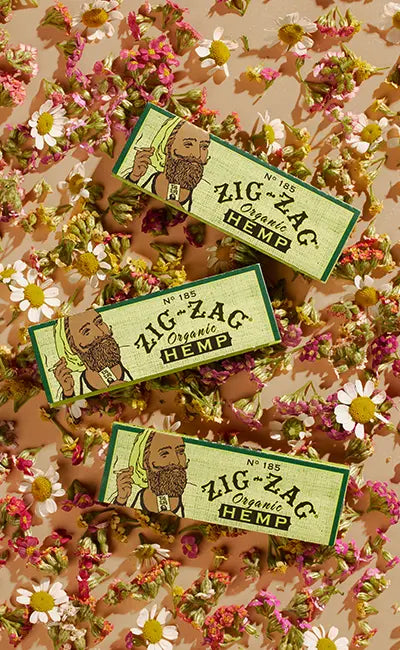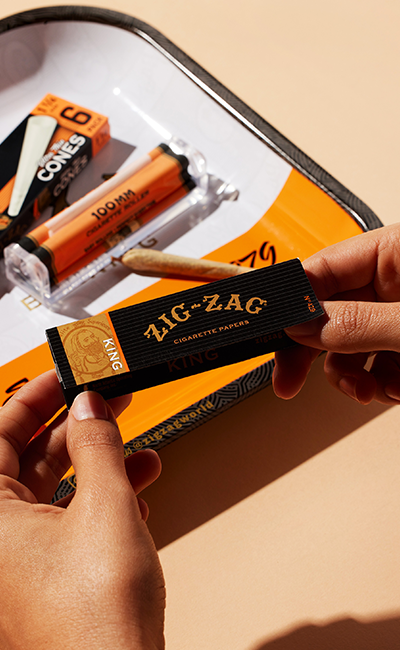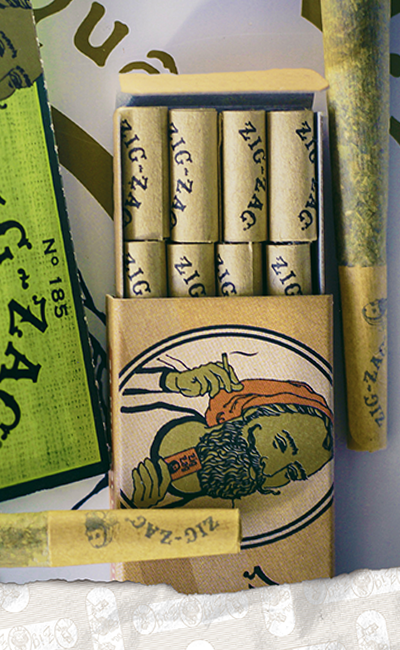Hemp cones are pre-rolled smoking papers made from hemp plant fibers, offering an eco-friendly and natural alternative to traditional rolling papers. These are designed for ease of use, allowing smokers to simply pack their material into the cone without the need to roll manually. Many people choose them because they are made without harsh chemicals or additives, which supports a smoother, cleaner smoking experience.
Natural hemp cones stand out because they are crafted using unbleached, plant-based materials, making them one of the most preferred choices for those looking to enjoy a more organic smoking session.
The Benefits of Hemp Cones for a Cleaner Smoke
Chemical-Free Rolling
One of the most important reasons smokers turn to chemical-free rolling cones is the ability to enjoy a purer, cleaner experience. Made without chlorine, dyes, or artificial additives, it means you aren't inhaling unwanted substances that can alter the quality of your session. This focus on chemical-free materials enables smokers to enjoy their herbs without concern for additional toxins in the process. Using hemp cones reduces the risks associated with treated papers and helps maintain the integrity of the herbs or blends being smoked.
Slow and Even Burn
Achieving a consistent burn is key to fully enjoying their sessions.
Hemp cones for smoking are known for their ability to provide a slow, even burn that lasts longer than many traditional options. This steady burn helps avoid frustrating issues like canoeing, where one side burns faster than the other. A reliable, uniform burn also means less waste and more satisfaction from the material being used.
Enhancing Flavor
One of the standout features of herbal hemp cones is their ability to preserve and enhance the natural flavor of the smoking material. Unlike bleached papers or chemically treated wraps, hemp fibers do not overpower or distort the taste of the herbs inside. Instead, they allow the smoker to enjoy the true essence of the plant, making each puff taste fresh and authentic. The mild, neutral quality of hemp complements a variety of herbs and blends, providing an ideal balance that many smokers appreciate.
Reducing Irritation and Harshness
With
hemp cones for a natural smoke, this discomfort is often reduced because these cones are free from harsh substances that can contribute to coughing or burning sensations. The smooth texture and natural composition of hemp paper promote a gentler smoke that feels easier on the respiratory system. It makes them an excellent option for those who are sensitive to strong or irritating smoke.
Sustainability and Eco-Friendly Advantages of Hemp Cones
Why Hemp Is a More Sustainable Option
The hemp plant is known for its fast growth and minimal need for pesticides, making it one of the most environmentally friendly crops available. Choosing sustainable smoking products like hemp cones supports this eco-conscious approach by reducing reliance on materials that harm the earth. Hemp requires less water and grows well without chemical fertilizers, which helps lower its environmental impact.
Biodegradable and Renewable
Over time, these break down naturally, producing little to no hazardous waste. The best natural hemp cones are biodegradable and made from renewable hemp fibers, offering a solution that minimizes environmental pollution. Unlike synthetic or bleached rolling papers, hemp cones decompose easily without introducing toxic substances into the soil or water. Their production process is generally cleaner, relying on fewer chemicals, which further reduces their ecological footprint. Supporting biodegradable products helps reduce the amount of waste in landfills, making hemp cones an ideal choice for smokers who care about the health of our planet.
Supporting Sustainable Smoking Practices
Opting for organic hemp cones is not only a personal decision but also one that supports broader environmental responsibility. Many companies that produce all-natural rolling cones prioritize ethical sourcing and fair labor practices, striving to make their supply chain as transparent and responsible as possible. This choice helps foster a market where environmentally conscious products thrive, contributing to long-term ecological well-being.
Choosing the Best Hemp Cones for Your Smoking Preferences
How to Identify High-Quality Products
It’s important to know how to spot high-quality options that will give you the best smoking experience. Below are some helpful tips for recognizing top-tier hemp cones:
-
Check for Organic Certification: A hallmark of excellence in hemp products is verification by a reputable organic certifier. Look for seals issued by recognized bodies, such as USDA Organic (United States) or third-party organizations like Ecocert and Oregon Tilth. These certifications guarantee that the hemp was cultivated without synthetic fertilizers, herbicides, or pesticides—substances that can linger on plant fibers and ultimately be inhaled. When examining packaging, note the certifier’s logo, certificate number, and the farm’s name or code. Many brands provide a QR code or web link to their certification documents, enabling you to trace the supply chain from field to cone. Beyond chemical exclusion, organic standards often require crop rotation, soil conservation, and biodiversity measures, which translate into healthier soils and more robust hemp fibers. Well-sourced organic hemp tends to retain its natural terpenes and cannabinoid profile more faithfully, resulting in a cleaner taste and a smoother draw.
-
Look for Unbleached Hemp Paper: The bleaching process used in conventional rolling papers often involves chlorine or peroxide treatments to achieve a stark white appearance. These chemicals can leave trace residues that compromise both health and flavor. Unbleached hemp cones, on the other hand, showcase the plant’s inherent tan or light brown hues, a sign that the fibers have remained untouched by harsh agents. Beyond the visual cue, unbleached paper preserves the natural lignin and cellulose structure, resulting in stronger fiber bonds that resist tearing during packing and lighting. When evaluating a product, run your fingertip lightly across the product’s surface. High-quality, unbleached variants feel slightly textured and fibrous, yet supple enough to conform to your content. Because no whitening additives are present, the smoke retains its authentic hemp aroma, free of the medicinal or chemical undertones that bleached papers sometimes impart.
-
Inspect the Cone’s Construction: Even the finest hemp paper loses luster if the cone is poorly assembled. Examine the tip and seam for uniformity: the adhesive line should lie flush with the paper, free of gaps or bulges that could disrupt airflow or trigger runs. A well‑constructed cone presents a gradually tapering shape from mouthpiece to tip, allowing for consistent packing density and an even burn rate. Gently squeeze the body of the cone to ensure it retains structural integrity without collapsing; overly flimsy cones signal insufficient paper weight or subpar adhesive formulation. When you tap the mouthpiece lightly, you should feel a slight springback, indicating the paper is neither too thick (which can restrict draw) nor too thin (which can lead to tunneling).
-
Evaluate User Reviews and Ratings: Seek out user reviews on reputable platforms, such as specialized hemp forums, lifestyle websites, or verified purchase sections of e‑commerce sites. Focus on comments that address burn consistency (e.g., absence of canoeing or tunneling), flavor neutrality, and ease of packing. Detailed testimonials often mention how the cone held its shape through multiple relights, or whether the paper produced a smooth, ash‑white residue. Be cautious of products with an overwhelming number of one-word ratings; instead, prioritize balanced, descriptive reviews that include photos or videos for added context. Compare ratings across several retailers to identify patterns—a high average score accompanied by dozens of reports about even burning signals reliable quality. Additionally, look for reviews that mention the brand's responsiveness to customer concerns or replacements sent for defective cones.
Armed with this criteria, you’ll be well‑equipped to select alternatives to traditional rolling papers that deliver a clean smoking ritual every time.
Comparing Hemp Cones for Cannabis and Herbal Blends
Choosing between hemp cones for cannabis smoking and those suited for herbal blends depends largely on your personal preferences and the smoking material you plan to use. Selecting the right type helps preserve the taste and texture of your chosen herbs, preventing overpowering flavors. Matching the cone size to your needs ensures the smoking session remains smooth and enjoyable from start to finish.
Flavored vs. Unflavored Hemp Cones
Flavored cones can add sweetness, spice, or fruity notes to your smoke, which can enhance or mask the natural taste of your herbs. On the other hand, premium hemp cones without added flavors allow the natural essence of your material to stand out clearly. Those who enjoy pure, unaltered taste usually prefer unflavored options. Meanwhile, flavored cones may appeal to smokers seeking to explore new sensory experiences.
Where to Purchase Hemp Cones Online
Trusted online stores like Zig-zag often provide customer reviews, which help measure the consistency and satisfaction levels of their products. They offer detailed descriptions of their manufacturing processes and sourcing, giving buyers added confidence in their purchases. Shopping online offers access to a wide variety of options.
How to Use Hemp Cones for an Optimal Smoking Experience
Packing and Filling Tips
Getting the best results from your hemp cones begins with how you pack them. Evenly distributing your smoking material ensures that the cone burns smoothly from start to finish. Overpacking can cause airflow issues, making it difficult to draw correctly, while underpacking might lead to loose material falling out or uneven burning. The ideal approach is to pack the material gently but firmly, using a tamper or similar tool to help create a uniform fill. Ensuring balance in how tightly the cone is filled prevents frustration during the session and helps maximize enjoyment.
Storing Hemp Cones to Maintain Freshness
Properly storing your hemp cones is crucial for preserving their pliability, preventing mold growth, and ensuring an enjoyable experience every time you reach for one. Here is a guide:
-
Use Airtight Storage Containers: Oxygen is one of the principal culprits behind paper degradation, as it accelerates oxidative reactions that weaken fibers and dull natural oils. To counteract this, select storage vessels with reliable seals—mason jars with rubber-gasket lids, vacuum-seal canisters, or thick-walled plastic tubs with silicone gaskets all work exceptionally well. Before placing your cones inside, ensure the container is completely dry, as any residual moisture can promote the growth of mildew. If you’re using a vacuum-seal system, remove as much air as possible without crushing the cones; this low-oxygen environment slows down the chemical breakdown of the hemp fibers and helps conserve the cones’ original texture. For larger collections, consider dividing your cones into smaller batches and storing them in separate containers—this minimizes the frequency of opening any single jar and reduces repeated air exposure.
-
Keep Cones Away from Direct Sunlight: Ultraviolet rays and intense illumination can have a dehydrating effect on hemp paper, stripping away moisture and natural oils that grant the cone its supple feel. Prolonged sun exposure can cause the paper to stiffen, develop hairline cracks, or fade unevenly. To prevent these outcomes, choose a storage spot that remains shaded throughout the day, such as an interior cabinet, drawer, or opaque box. Even filtered light through curtains can be strong enough to initiate photodegradation, so avoid placing cones on windowsills or near bright lamps. If you habitually store other smoking accessories above your cones, ensure the lid of your container blocks stray beams entirely.
-
Store at Stable, Cool Temperatures: Fluctuations in heat and cold trigger expansion and contraction cycles within the hemp fibers, potentially loosening the adhesive bonds at seams and causing microscopic fissures to form. Ideally, aim to keep cones in an environment with a temperature range of 18–22 °C (64–72 °F), where temperature fluctuations are minimal and predictable. Avoid locations near heating vents, radiators, or air-conditioning units that cycle on and off, as these can introduce sudden spikes or drops in temperature. Likewise, basements and garages—where temperatures may swing dramatically between day and night—are suboptimal for long-term storage. A climate‑controlled drawer or a dedicated cabinet within your living space offers the consistency needed to protect delicate papers.
-
Avoid Overhandling the Cones: Every time you touch a hemp cone, you risk transferring natural oils, dirt, or moisture from your fingertips onto the paper’s surface. These contaminants can compromise the cone’s burn characteristics and leave spots that darken or stiffen when exposed to heat. To minimize this, handle cones sparingly and only when you’re prepared to pack them immediately. If you need to sort or inspect your inventory, consider wearing clean, lint‑free gloves or using a pair of smooth tweezers to reduce direct contact.
-
Use Humidity Packs if Necessary: In arid climates, even sealed containers can succumb to slight moisture loss over time, causing cones to become overly brittle and prone to cracking when bent or packed. To counteract this, insert a regulated humidity pack into your storage vessel alongside the cones. These packs are designed to maintain a precise relative humidity (RH) level, often around 58 percent, by releasing or absorbing moisture as needed. This stable microclimate keeps hemp fibers supple, prevents seam failure, and preserves the cone’s natural aroma.
By taking a few extra steps to preserve their condition, you ensure that your cones remain ready for use whenever you want to enjoy a session.
There is a growing recognition of the many
benefits of smoking hemp cones, especially among individuals seeking a more natural and enjoyable smoking experience. These cones offer an option that supports both personal well-being and environmental responsibility, distinguishing them from traditional rolling products. Their chemical-free design makes them an attractive option for anyone seeking to minimize exposure to unwanted additives.






